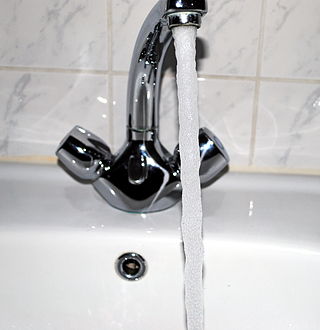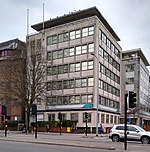
The Water Services Regulation Authority, or Ofwat, is the body responsible for economic regulation of the privatised water and sewerage industry in England and Wales. Ofwat's main statutory duties include protecting the interests of consumers, securing the long-term resilience of water supply and wastewater systems, and ensuring that companies carry out their functions and are able to finance them.

Water supply is the provision of water by public utilities, commercial organisations, community endeavors or by individuals, usually via a system of pumps and pipes. Public water supply systems are crucial to properly functioning societies. These systems are what supply drinking water to populations around the globe. Aspects of service quality include continuity of supply, water quality and water pressure. The institutional responsibility for water supply is arranged differently in different countries and regions. It usually includes issues surrounding policy and regulation, service provision and standardization.
Dŵr Cymru Welsh Water is a not-for-profit company which supplies drinking water and wastewater services to most of Wales and parts of western England that border Wales. In total, it serves around 1.4 million households and businesses and around three million people - and supplies nearly 830 million litres of drinking water per day.

Thames Water Utilities Ltd, known as Thames Water, is a large private utility company responsible for the water supply and waste water treatment in most of Greater London, Luton, the Thames Valley, Surrey, Gloucestershire, north Wiltshire, far west Kent, and some other parts of England; like other water companies, it has a monopoly in the regions it serves.

Northern Ireland Water Limited is the main water company in Northern Ireland.

Water supply and sanitation in the United Kingdom is provided by a number of water and sewerage companies. Twelve companies and organisations provide drainage and sewerage services, each over a wide area, to the whole United Kingdom; and supply water to most customers in their areas of operation. There are also 'water only' companies which supply water in certain areas. Some companies are licensed to supply water or sewerage services using the networks of other providers.
Guyana, meaning "land of many waters", is rich in water resources. Most of the population is concentrated in the coastal plain, much of which is below sea level and is protected by a series of sea walls. A series of shallow reservoirs inland of the coastal plain, called "water conservancies", store surface water primarily for irrigation needs. Key issues in the water and sanitation sector in Guyana are poor service quality, a low level of cost recovery and low levels of access.
Public water supply and sanitation in the United Kingdom is characterised by universal access and generally good service quality. A salient feature of the sector in the United Kingdom compared to other developed countries is the diversity of institutional arrangements between the constituting parts of the UK, which are each described in separate articles, while this article is devoted to some common issues across the United Kingdom.
Public water supply and sanitation in Germany is universal and of good quality. Some salient features of the sector compared to other developed countries are its very low per capita water use, the high share of advanced wastewater treatment and very low distribution losses. Responsibility for water supply and sanitation provision lies with municipalities, which are regulated by the states. Professional associations and utility associations play an important role in the sector. As in other EU countries, most of the standards applicable to the sector are set in Brussels. Recent developments include a trend to create commercial public utilities under private law and an effort to modernize the sector, including through more systematic benchmarking.

The water privatisation in England and Wales involved the transfer of the provision of water and wastewater services in England and Wales from the state to the private sector in 1989, through the sale of the ten regional water authorities (RWA). The potable water supply as well as the sewerage and sewage disposal functions of each RWA were transferred to privately-owned companies.
Public water supply and sanitation in Denmark is characterized by universal access and generally good service quality. Some salient features of the sector in the Denmark compared to other developed countries are:
Water supply and sanitation services in Ireland are governed primarily by the Water Services Acts of 2007 to 2014 and regulated by the Commission for Energy Regulation. Until 2015, the relevant legislation provided for the provision of water and wastewater services by local authorities in Ireland, with domestic usage funded indirectly through central taxation, and non-domestic usage funded via local authority rates. From 2015, the legislation provided for the setup of a utility company, Irish Water, which would be responsible for providing water and wastewater services, and funded through direct billing. The transition between these models, and certain aspects of operation of the new company, caused controversy in its initial period of operation.
Water supply and sanitation in the Netherlands is provided in good quality and at a reasonable price to the entire population. Water consumption is one of the lowest in developed countries at 128 litres per capita per day and water leakage in the distribution network is one of the lowest in the world at only 6%.
Public water supply and sanitation in Scotland is characterised by universal access and generally good service quality. Water and sewerage services are provided by a single public company, Scottish Water. The economic water industry regulator is the Water Industry Commission for Scotland. It "promotes the interests of water and sewerage customers in Scotland by making sure that householders and businesses receive a high-quality service and value for money by setting prices, monitoring Scottish Water's performance and facilitating competition in the water industry". The environmental regulator is the Scottish Environment Protection Agency. Drinking water standards and wastewater discharge standards are determined by the EU.
Drinking water supply and sanitation in Egypt directly impact the country's public health, industrial developments, and agriculture. Egypt's water and sanitation industry is characterized by both achievements and challenges. Among the achievements are an increase of piped water supply between 1998 and 2006 from 89% to 100% in urban areas and from 39% to 93% in rural areas despite rapid population growth; the elimination of open defecation in rural areas during the same period; and in general a relatively high level of investment in infrastructure. Access to an at least basic water source in Egypt is now practically universal with a rate of 98%. On the institutional side, the regulation and service provision have been separated to some extensions through the creation of a national Holding Company for Water and Wastewater in 2004, and of an economic regulator, the Egyptian Water Regulatory Agency (EWRA), in 2006. Despite these successes, many challenges remain. Only about one half of the population is connected to sanitary sewers. Because of this low sanitation coverage, about 50,000 children die each year because of diarrhea. Another challenge is low cost recovery due to water tariffs that are among the lowest in the world. This in turn requires government subsidies even for operating costs, a situation that has been aggravated by salary increases without tariff increases after the Arab Spring. Furthermore, poor operation of facilities, such as water and wastewater treatment plants, as well as limited government accountability and transparency, are also issues.
A regional water authority, commonly known as a water board, was one of a group of public bodies that came into existence in England and Wales in April 1974, as a result of the Water Act 1973 coming into force. This brought together in ten regional units a diverse range of bodies involved in water treatment and supply, sewage disposal, land drainage, river pollution and fisheries. They lasted until 1989, when the water industry was privatised and the water supply and sewerage and sewage disposal parts became companies and the regulatory arm formed the National Rivers Authority. Regional water authorities were also part of the Scottish water industry when three bodies covering the North, West and East of Scotland were created in 1996, to take over responsibilities for water supply and sewage treatment from the regional councils, but they only lasted until 2002, when they were replaced by the publicly owned Scottish Water.
Water supply and sanitation in Japan is characterized by numerous achievements and some challenges. The country has achieved universal access to water supply and sanitation, has one of the lowest levels of water distribution losses in the world, regularly exceeds its own strict standards for the quality of drinking water and treated waste water, uses an effective national system of performance benchmarking for water and sanitation utilities, makes extensive use of both advanced and appropriate technologies such as the jōkasō on-site sanitation system, and has pioneered the payment for ecosystem services before the term was even coined internationally. Some of the challenges are a decreasing population, declining investment, fiscal constraints, ageing facilities, an ageing workforce, a fragmentation of service provision among thousands of municipal utilities, and the vulnerability of parts of the country to droughts that are expected to become more frequent due to climate change.
The Drinking Water Directive 2020 is an EU law that protects the quality of drinking water and forms part of the regulation of water supply and sanitation in the European Union.

The Water Act 1989 is an Act of the Parliament of the United Kingdom that reorganised the bodies responsible for all aspects of water within England and Wales. Whereas previous legislation, particularly the Water Act 1973, had focused on providing a single unifying body with responsibility for all water-related functions within a river basin or series of river basins, this legislation divided those functions up again, with water supply, sewerage and sewage disposal being controlled by private companies, and the river management, land drainage and pollution functions becoming the responsibility of the National Rivers Authority.
There are a large number of reservoirs in Wales reflecting the need for the supply of water for both industry and for consumption, both within the country itself and in neighbouring England. A number also provide hydroelectricity and many old reservoirs also provided motive power for industries, especially for the processing of minerals such as metal ores and slate.










